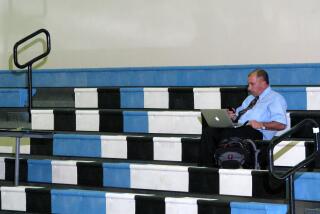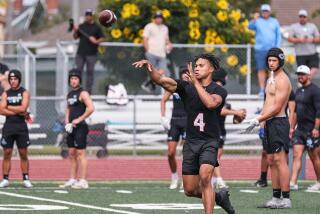Transfers Make Them Lose It
SELMA, Calif. — In the raisin capital of the world, a coach and his basketball team are taking a stand, which is why the gymnasium at Selma High will be dark tonight.
Selma is forfeiting rather than play San Joaquin Memorial in boys’ basketball this season because it believes its Central Sequoia League rival broke transfer rules to admit two of its star players.
“They’ve made their choices and we’re making ours,” Selma Coach Randy Esraelian said. “Selma is leading the way in cleaning up high school sports. We’re willing to give up a chance for the league championship in order to get this issue in the forefront.”
Already, Selma refused to play Memorial in the championship game of a tournament, forcing organizers to revise the schedule. They will take losses for league games tonight and on Feb. 8.
Officials from Memorial deny recruiting allegations. An investigation concluded in September by the Central Section, the organization that governs high school competition in the Central Valley, cleared the school of any wrongdoing.
Those results aside, Esraelian, a fifth-grade teacher, said he wants to set an example for his players by shedding light on transfers who find a way to bend regulations, creating an “unlevel” playing field.
On that point, Selma, located 20 miles south of Fresno, may have already won.
The Central Section appointed a 12-member committee Wednesday for a review of transfer policies. It was sparked in part by the flap between Selma and Memorial and a recognition that current regulations might not go far enough to crack down on recruiting and transfer activities that critics say corrupt the spirit of high school sports.
Statewide, the number of high school athletes switching schools has skyrocketed in recent years, frustrating coaches, administrators and parents, and triggering calls for reform even within the California Interscholastic Federation, the state governing body for high school sports.
“The whole state is trying to tighten transfer rules,” said Jim Crichlow, commissioner of the Central Section, which oversees Selma and San Joaquin Memorial. “It’s the No. 1 topic of discussion.”
Not all of the CIF’s 10 sections keep transfer records, but many coaches and administrators seem to agree the practice has reached epidemic proportions in the City and Southern sections, which supervises high schools competition in Southern California.
In the 522-school Southern Section, there were nearly 3,800 athletic transfers--not counting moves prompted by a change in residence--from the fall of 1999 through December of last year. The 60-school City Section had 945 in the same span.
Athletes are allowed to keep their eligibility without changing residence once in their four-year high school career. Transferring for athletic purposes is not allowed, but students routinely use the 1994 state law on open enrollment to move from school to school.
Open enrollment allows students to attend schools outside their local district where there is space available. It was designed to help improve academic performance by encouraging schools to compete for top students, but critics say it has been used as a loophole by athletes who want to switch to schools where they can better showcase their athletic ability.
Jim Staunton, commissioner of the Southern Section, the CIF’s largest section, estimates he and three assistant commissioners spend four hours each working day on transfer forms, calls or inquiries.
“Open enrollment has allowed a number of parents to relocate their athletes if they become dissatisfied with their local school coach,” Staunton said.
Another common thread among transfers: The alleged influence of club coaches. “The rise in club programs has caused a number of coaches to advise parents on where to send their athletes,” Staunton said. “I see it as a manipulation of the system.”
The problem has grown so unsettling that some leagues and school districts have started to implement their own transfer restrictions, requiring athletes who change schools without moving to sit out one varsity season. Others have been forced into action after embarrassing incidents involving foreign-exchange students.
Artesia High had to forfeit two section titles and all victories in the 1997-98 and 1999-2000 seasons after eligibility questions were raised about players from the Dominican Republic and Iceland.
In September, the Clovis Unified School District voted to make foreign-exchange students who transfer into the district ineligible to compete at the varsity level for one year. The impetus was Charlie Rodriguez, a basketball player from the Dominican Republic who transferred to Clovis West and was found to be 19 as a sophomore. Clovis West had to forfeit 70 boys’ basketball victories and two section titles in 1998-99 and 1999-2000.
Last month, a Superior Court judge in Stanislaus upheld a CIF decision to declare two players from England, Richard Midgley and Marc Pratt, ineligible this season at Modesto Christian High. They led the school’s basketball team to the state Division I final last season. The CIF ruled they had exhausted their eligibility.
Transfers have become so influential that City Section Commissioner Barbara Fiege said a coach recently suggested, playfully, that, “Maybe our two [competitive] divisions should be based on who has transfers and who doesn’t.”
Said Fiege: “I laughed, but I’m thinking, ‘Maybe it’s not too crazy.’”
The transfers that sparked Selma’s action brought Memorial guard Dwain Williams from Riverside County and forward Antonio Lawrence from Florida. Lawrence’s mother was hired last summer to work in the Memorial attendance office.
Williams and Lawrence also play for a Fresno-based, adidas-sponsored travel team run by Darren Matsubara, a former Cal State Northridge player. Another member of Matsubara’s travel team, junior Nick Stigger from Memphis, Tenn., transferred to Van Nuys Montclair Prep last month. Stigger, who is living in the school’s boarding facility, scored 36 points in his debut last week.
Matsubara is an acquaintance of Wil Hooker, Memorial’s first-year coach. Selma officials believe Matsubara played a role in the players’ decision to transfer, allegations he denies.
Matsubara has been out of town and unavailable for comment, but in July he told the Fresno Bee that he did not steer Lawrence to Memorial. “I would never tell him or any player where to go or not to go,” Matsubara told the newspaper.
Crichlow, the Central Section commissioner, said he never received a return phone call from Matsubara for his investigation. Memorial also looked into the transfers, but didn’t talk to Matsubara either.
Steve Bojorquez, Selma’s superintendent, said he was at a meeting of the league’s top-ranking administrators where Memorial officials were questioned about their internal probe.
“It was apparent they had not even talked to [their] coach about whether he had any contact with Darren Matsubara.... That was one flag,” Bojorquez said. “An extensive investigation didn’t take place.”
Dennis DuPertuis, Memorial’s vice principal, defends his school and coach against recruiting allegations. He said both players contacted the school about transferring before Hooker was hired as coach. And he denied any school connection with Matsubara. “No one from our school said to these students, ‘Why don’t you come here?’” he said.
The Central Sequoia League is comprised of Selma, Memorial and three other schools, but only Selma has challenged the transfers. But that doesn’t mean others aren’t supporting Selma.
“I’m sympathetic,” Sierra Athletic Director Robert Hayden said. “I guess someone has to stand up to the problems we’ve got.”
Selma is an unlikely lead crusader in transfer and recruiting issues. With only one public high school in its 11-school district, it’s hardly an athletic powerhouse.
The popularity of the Future Farmers of America club, which has double the membership of the football team, is a reflection of those who live in the surrounding blue-collar farming communities. The 130-acre headquarters for Sun-Maid Growers is located just three miles away in Kingsburg and is one of the region’s largest employers. Nearly 74% of the 1,347 student body is Latino.
By contrast, Memorial is the only Catholic school in Fresno, well-respected for a college preparatory curriculum that costs $6,200 a year and enables 98% of its mostly white student body to move on to four-year schools. Its football and girls’ basketball teams have been recognized among the best in the Fresno area. The boys’ team entered this week with a 14-5 record, including a victory over Garces, one of the top teams in Bakersfield.
Esraelian’s teams have successfully competed against Memorial for seven years, posting about 10 victories against four losses, the coach estimated. The two transfers would make victories this season especially challenging, but he is adamant that he is not ducking Memorial because his team might get beat.
“It’s not about how bad they could beat us, or if we could beat them,” Esraelian said. “The whole point is, are we going to raise this issue?”
The decision to forfeit is viewed as courageous by some in the community and a mistake by others. And it wasn’t entirely popular even on its own campus.
“At first, it was a disappointment,” Kendall Reynolds, a junior who plays guard for Selma said of the decision. “Why not play them? [But] as weeks went by, a lot of people understood.”
Superintendent Bojorquez said forfeiting games should be a last resort--and it was. “The vast majority of people have been very supportive of taking a stand because most people know [recruiting] is happening and difficult to tie down,” he said. “But something has to be done.”
This isn’t the first time Selma has forfeited an athletic event to Memorial--in 1978, the girls’ basketball team forfeited to Memorial because of similar recruiting allegations. And if the transfers keep rolling in, it might not be the last.
Said Esraelian: “We’ll be playing for second place year in and year out if it’s not addressed.”
More to Read
Get our high school sports newsletter
Prep Rally is devoted to the SoCal high school sports experience, bringing you scores, stories and a behind-the-scenes look at what makes prep sports so popular.
You may occasionally receive promotional content from the Los Angeles Times.







